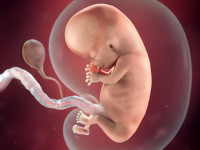Opening Our Eyes to Life in order to Open Our Mouths for It
For you formed my inward parts; you knitted me together in my mother’s womb. (Psalm 139:13)
As medical technology advances, our view through the womb’s virtual window has gotten clearer, allowing us to better appreciate the great gift God gives therein. In the preceding articles in this series, we’ve witnessed the magical moment of conception, the sudden start of Baby’s heart (at 22 days!), the stretching of his arms and kicking of his feet. Thanks to new 4D scans, we’ve even seen Baby grimace in response to unpleasant experiences and smile in response to pleasurable ones. This month we will complete Baby’s journey to birth.
Recent research is showing that by 28 weeks, Baby is beginning to become conscious of his world and even to store and retrieve memories. 4D scans have even showed babies in the third trimester experiencing rapid eye movement (REM) sleep, which is a sign (in born babies and adults) of dreaming. It’s possible that babies in the womb dream!
Further, research also shows that Baby is able to recognize his mother’s voice with its rhythms and patterns and respond to them. Fascinatingly, some researchers have even observed patterns in newborns’ cries that match the patterns in their mother’s voice!
Research is even showing how music affects babies in the womb. Fast music may excite Baby, while classical and choral music, which tend to be closer to natural human voice, may calm and relax Baby. If he hears the same music over and over again (like his mother singing in church), he may be able to remember it (by 33 weeks he is able to jump in time to it!).
Physically, Baby, in the third trimester, may turn head down in preparation for birth. Mom, as a result, may begin to experience Baby kicking in her ribs (some of which may be painful). By 31 weeks, many women begin to experience miniature contractions known as Braxton Hicks (the body’s preparation for delivery). By this point in his development, Baby can hear, taste, touch, and smell. He’s just over 2 pounds, but will more than triple in weight before birth. In just over 8 months, Baby has grown approximately 100 billion neurons with 100 trillion connections!
When the time for birth arrives (a time determined by Baby’s body), Baby’s lungs secrete a protein into the amniotic fluid, which changes the placenta’s production of hormones. This slows the release of the hormone progesterone and triggers the secretion of oxytocin, which, in turn, initiates contractions in the uterus. Interestingly, oxytocin also inhibits memory, which may help moms forget the pain of labor and delivery and facilitate their bonding with their baby.
As mom experiences contractions, which steadily move Baby toward birth, Baby’s body produces large amounts of adrenaline to keep his heart pumping enough blood and to help prepare his lungs for life outside the womb. As soon as Baby is delivered, the fluid in his lungs empties and air rushes in. Amazingly, in that moment, Baby transitions from a world of water to a world of air; his body knows to make the switch instantly.
The road from conception to birth is truly awe-inspiring. From the instant sperm meets egg, a new life is conceived. At that moment, this new life ceased being a potential person; he became a person with potential and a person in need of protection. Sadly, every 23 seconds a baby is aborted in America. In the time it takes you to read this article, 10 babies will be killed in the womb—legally. In the course of 24 hours, 3,200 unborn babies will be killed in our country–legally. Since the Supreme Court’s landmark Roe v. Wade, about 60 million babies have been killed—legally. To understand the enormity of this number, imagine the citizens of the following states being executed: Iowa, Minnesota, Missouri, Illinois, Kansas, Nebraska, South Dakota, Indiana, Wisconsin, Colorado, Kentucky, and North Dakota. That still falls shy of 60 million.
This number doesn’t simply represent dead babies; it represents millions of moms and dads who are living with silent pain. Many women who choose abortion undergo intense emotional turmoil. Among the most frequent difficulties reported by post-abortive women are: depression, loss of self-worth, self-destructive behavior, sleep disorders, memory loss, sexual dysfunction, chronic relationship problems, dramatic personality changes, anxiety attacks, guilt, difficulty grieving, increased tendency toward violence, chronic crying, difficulty concentrating, flashbacks, loss of interest in activities and people she once enjoyed, and difficulties bonding with later children. Many women turn to drugs or alcohol to numb their pain. A large percentage also report thoughts of suicide; many women attempt it.
In addition to the dead babies and emotional pain for women who abort, abortion brings with it numerous unmentioned risks. Studies of post-abortive women have found that, compared to women who carried their babies to term, women who chose abortion in the year previous to their death were 1.6 times more likely to die of natural causes, 7 times more likely to die from suicide, 4 times more likely to die from injuries received in accidents, and 14 times more likely to die from homicide. Many of these are attributable to the emotional pain that post-abortive women are unable to endure that drives them to life-risking behaviors.
Abortion can also cause serious medical problems. Abortion increases the risk of ectopic pregnancy. In fact, research shows that since Roe v. Wade the rate of ectopic pregnancies has increased by 300%! Pelvic Inflammatory Disease is another common effect of abortion. Women who suffer from this post-abortive infection have significantly higher rates of spontaneous abortions in subsequent pregnancies, infertility, dyspareunia (pain during or after sexual intercourse), and chronic pelvic pain. Abortion also increases the risk of placenta previa in subsequent pregnancies. (This is a condition in which the placenta covers the cervix and prevents Baby from passing through the birth canal). Among other medical problems produced by abortion are: increased risk of tubal infertility, increased risk of premature birth, low birth weight, and malformations in subsequent children, increased risk of breast cancer, increased risk of death due to complications caused by abortion.
And yet, many in our country consider abortion a necessary component of “quality” health care (that tax payers should fund). But what in the four previous paragraphs can be considered “quality”? Are dead babies “quality”? Are women in the throes of emotional turmoil “quality”? Are untold elevated health risks “quality”? Some emphasize that abortion needs to be “safe.” Even if we eliminate the Kermit Gosnells of the world, how is abortion “safe”? It terminates the life of a child; how is that “safe”? Abortion leaves a laundry list of emotional pain that wrecks women’s lives; how is that “safe”? Abortion dramatically increases the risk of numerous diseases and complications for women and subsequent pregnancies and children; how is that “safe”?
In truth, nothing in abortion is “quality” or “safe.” These are but lies of Satan, the enemy of life. We, however, know the Creator and Redeemer of life. Only He can heal what is broken and expose the deceptions of the devil. For the sake of life (whether unborn or born, child or adult), we need to speak. Our eyes have been opened through the womb’s window. Now let our mouths be opened in its defense. But let us do more than defend the physical lives of mothers and their babies. Let us speak just as freely of the forgiveness and new life Christ offers to every man, woman, and child; He chose to give His life for them all.
Pastor Jonathan Conner of Zion Lutheran Church in Manning, Iowa, is a former board member for the Hausvater Project.





